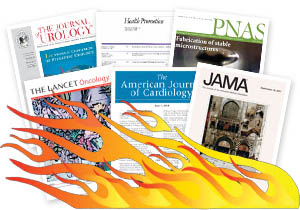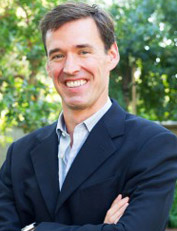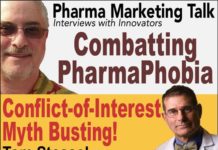Sizzle Sells, Even for Doctors Are Better Headlines Just What the Doctor Ordered?
Pharmaguy interviews Jeff Tangney, CEO & Founder, Doximity (see Bio), who talks about physician clinical reading patterns and trends and the impact on patient care. The discussion focuses on how Doximity has added some ‘sizzle’ to life-saving medical news to make it more readable and engaging for its online physician community.
Air Date: Thursday, 8 Jan 2015
Check Out Business Podcasts at Blog Talk Radio with Pharmaguy on BlogTalkRadio
You can also visit this Pharma Marketing Talk Segment Page and listen to the archived audio podcast. This show and ALL Pharma Marketing Talk shows are available as podcasts via PMT on iTunes (FREE!).
Background
 Nearly 75 percent of physicians change their clinical practices quarterly or monthly based on reading medical literature, according to a Doximity survey conducted in July, 2014. The survey also found that 98 percent of physicians reported reading medical literature is important or very important to their practice. More than 50 percent of US physicians are members of Doximity’s professional network.
Nearly 75 percent of physicians change their clinical practices quarterly or monthly based on reading medical literature, according to a Doximity survey conducted in July, 2014. The survey also found that 98 percent of physicians reported reading medical literature is important or very important to their practice. More than 50 percent of US physicians are members of Doximity’s professional network.
However, despite the perceived value of medical literature, it can be challenging for physicians to keep up on news. A report in the Journal of the American Medical Library Association (JAMLA) found that over 7,000 articles are published monthly in primary care journals alone.
“Medicine has a TL;DR problem (Too Long; Didn’t Read),” said Nate Gross, MD, co-founder of Doximity. “It would take 20 hours of reading each day for the average physician to comb through everything published in their speciality. At Doximity, we address this issue by identifying the most important news for an individual member and delivering it straight to them – saving time and ensuring that life-saving clinical news is actually read.”
Survey findings:
- 98 percent of physicians reported that reading medical literature was important or very important to their practice.
- 16 percent of physicians reported that reading medical literature directly helped save the life of a patient in the last year, with medical news of rare immune disorders, new melanoma treatments and stroke guidelines cited in physician stories.
- When asked how often reading medical literature directly changed their clinical practice with patients, 14 percent of physicians reported changing weekly, 28 percent reported monthly, 44 percent reported quarterly and 14 percent reported yearly.
- 44 percent of physicians reported spending 1 to 2 hours a week reading news online on a smartphone, computer or tablet. 22 percent read news online 3 to 4 hours a week and 24 percent read more than 5 hours a week online. Only 10 percent read news online less than an hour a week.
Doximity’s Curator algorithm is used to power DocNews, the first and only service to automatically source medical news based on a physician’s professional interests, publishing history and clinical expertise – an average of 28 profile data points per member.
“Doximity’s DocNews offered timely news and a common platform to inform our practice and stimulate conversation among our surgeons about the best approaches for atrial fibrillation treatment,” said Hassan Tetteh, MD, a Washington DC-based surgeon specializing in thoracic surgery, critical care, and heart and lung transplantation. “Having a secure dynamic platform like Doximity to share knowledge and communicate with my medical colleagues is priceless.”
Questions/Topics of Discussion
- Why should anyone care about physicians reading clinical news?
- Medical publishing and journals are booth booming. How are doctors managing the tidal wave of new medical literature?
- How, when and why are doctors reading medical news today? What are the most interesting physician trends?
- How does Doximity’s DocNews feature work? Who does it reach?
- What are some case studies of boosting physician readership through Doximity? What has Doximity learned from testing and optimizing?
- What are the larger pros and cons of social news curation?
- What best-practices can life sciences learn from Doximity’s success with adding sizzle to medical news?
Guest Bio
 Jeff Tangney founded the physician network Doximity in 2010 and serves as its Chief Executive Officer. Prior to that, he co-founded Epocrates in 1998 and served as its President & Chief Operating Officer for 11 years.
Jeff Tangney founded the physician network Doximity in 2010 and serves as its Chief Executive Officer. Prior to that, he co-founded Epocrates in 1998 and served as its President & Chief Operating Officer for 11 years.
Mr. Tangney has over 15 years of healthcare experience including with ZS Associates, Goldman Sachs and Pangene Corporation.
He graduated from the University of Wisconsin, with a BS in Economics and earned an MBA from Stanford University’s Graduate School of Business.









![6 Digital Tools at the Center of Healthcare Digitalization [INFOGRAPHIC]](http://ec2-54-175-84-28.compute-1.amazonaws.com/pharma-mkting.com/wp-content/uploads/2021/04/6DigitalTools_600px-100x70.jpg)




